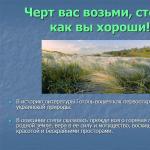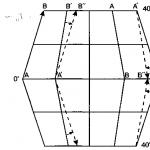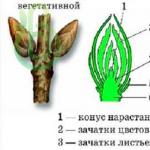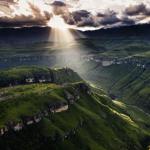Topic: General characteristics of the Russian economy
Lesson: Geography of agriculture, grain farming in Russia
Possessing the world's largest fund of land, including agricultural land, Russia, it would seem, has unlimited opportunities for the successful development of agriculture. However, unfavorable geographical location, climatic conditions and other features of the natural environment significantly limit these opportunities. Russia is the northernmost and coldest country in the world. Most (3/4) of its territory is located in the zone of cold and temperate climatic zones. Therefore, solar heat comes to it in a very limited amount, vast areas are occupied by permafrost. On the part of the Russian territory (approximately 35% of the country's area), located in the temperate zone, there is enough heat for the ripening of crops such as wheat, rye, barley, oats, buckwheat, flax, sugar beets, sunflowers, etc. However, over a huge area , located beyond the Arctic Circle (islands and the mainland coast of the Arctic Ocean), only vegetable growing in closed ground or focal agriculture is possible.
Rice. 1. Climatic zones of Russia
Due to differences in evaporation, the northern and northwestern regions are classified as waterlogged territories, while the southern regions (the eastern regions of the North Caucasus, the south of the Volga region, the Urals and Siberia) are arid. As a result, almost the entire territory of the country is located in the zone of risky farming (regions where the return of cold weather, drought or waterlogging is frequent and, as a result, lean years); growing most of the perennial crops in the country is impossible; most of its pastures fall on low-productive tundra lands; areas with favorable conditions for agriculture (the North Caucasus, the Central Black Earth region, the Middle Volga region) occupy a small space (slightly more than 5% of the country's territory). In terms of provision of heat and moisture, Russia is significantly inferior to many countries, including the United States, whose agro-climatic potential is more than 2.5 times higher, France - 2.25 times, Germany - 1.7 times, Great Britain - 1.5 times higher, than the RF.
If we consider the territory of Russia from north to south, i.e. according to natural zones, the geography of agriculture is as follows.
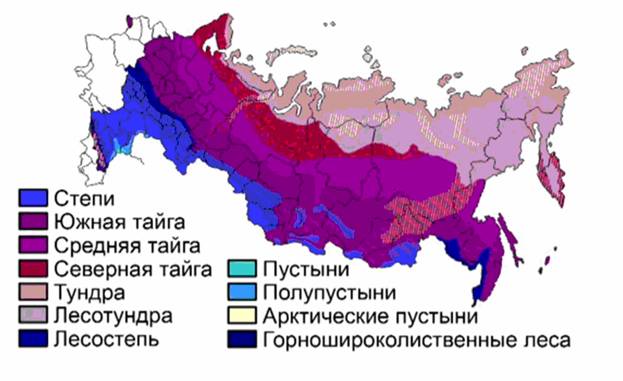
Rice. 2. Natural areas of Russia
Arctic desert zones, tundra and forest tundra either unsuitable at all or extremely unfavorable for agricultural activities. Agriculture in most of the territory in open ground is impossible. The predominant type of farming is extensive reindeer grazing and fur farming. Agricultural development forest zone, due to climatic (cool short summer, the predominance of precipitation over the amount of evaporation), soil (infertile podzolic, gray forest and marsh soils) and other conditions, it is associated with overcoming significant difficulties: land reclamation (drainage) of land, liming of soils, application additional fertilizers, clearing the territory (cleaning boulders, cutting down forests, uprooting stumps, etc.), etc. The plowed area of the forest zone is small, hayfields and natural pastures have significant areas. The main directions of the development of the economy are dairy and meat cattle breeding and flax growing, the production of early-ripening grains (rye, barley, oats) and fodder crops, potatoes. This is typical for the European part of Russia (North-Western, Northern (Vologda region), Central, Volga-Vyatka, Ural (Perm region, Udmurtia). Forest-steppe and steppe zone(Central Black Earth, North Caucasian, Volga regions, southern regions of the Urals, Western and Eastern Siberia) surpasses all others in terms of agro-climatic resources. In addition to high heat supply, the zone is characterized by the presence of various types of chernozem and chestnut soils, which are characterized by high fertility. Plowed land is very high. The zone is the main granary of the country, the main producer of agricultural products (almost 80% of the country's agricultural products, including the vast majority of wheat, rice, corn for grain, sugar beets and sunflowers, fruits and vegetables, melons and grapes, etc.). In animal husbandry, dairy-meat and meat cattle breeding, pig breeding, poultry farming and sheep breeding are developed. subtropical zone(Black Sea coast of the Krasnodar Territory) is very small in area, but it concentrates all the production of tobacco and tea in Russia. Mountainous territories Caucasus and Southern Siberia (Altai, Kuznetsk Alatau, Western and Eastern Sayans, mountains of Tuva, Baikal and Transbaikalia) stand out for their natural meadows used for pastures. Agriculture specializes in beef cattle breeding, sheep breeding, horse breeding, deer breeding, yak breeding, camel breeding. In the production of agricultural products of the country, approximately the same role belongs to crop production and animal husbandry.
crop production- the main branch of grain farming, whose crops (wheat, rye, corn, oats, barley, millet, buckwheat, etc.) occupy more than half of the country's sown area.
Half of the area allocated for grain crops is occupied by crops wheat. Wheat culture in Russia, as in other countries of the world, is most widespread in the steppe and forest-steppe zone. They grow winter and spring wheat. In areas where winter wheat is not damaged by frost (the North Caucasus, the Central Black Earth and the right-bank part of the Volga region), it is usually preferred as a more productive crop. East of the river The Volga (the left bank of the Volga region, the south of the Urals, Siberia and the Far East) is dominated by spring wheat crops. This pattern of distribution of winter and spring wheat crops is explained by the increase in the severity of winter towards the northeast.
Rye, compared with wheat, it has a lower growth start temperature, greater early maturity, frost resistance, and is able to successfully grow on acidic and nutrient-poor soddy-podzolic soils. Therefore, in areas located in the forest zone (North-Western, Central, Volga-Vyatka regions, the northern part of the Urals and the Volga region), rye is the main and most productive grain crop. In Russia, mainly winter varieties of rye are cultivated.
Corn- the most productive of cereals and the best silage culture. Silo - a structure in the form of a tower or pit, a moat for storing and fermenting watery feed: tops, stems, leaves, etc. In the southern regions of the European part of the country (North Caucasus, Central Black Earth and Volga regions), climatic conditions allow growing corn to get grain. In the more northern regions (Central, Volga-Vyatka, Ural) corn does not fully mature, and its plant mass is used for feeding livestock.
Oats and barley- plants with a short growing season, mainly grown in the northern regions of the European part (Northern, North-West regions), in the Urals and in Siberia.
Rice in Russia it is cultivated only under artificial irrigation. Rice crops are concentrated in the North Caucasus (the lower reaches of the Kuban, Don, Terek, Sulak rivers), the Lower Volga region (the Volga-Akhtuba floodplain of the Astrakhan region) and in the Far East in the Khanka lowland (the Lake Khanka region).
Millet and buckwheat, along with rice, the most important cereal crops, also occupy small areas. Millet, which is characterized by increased resistance to drought, is cultivated mainly in the arid steppe regions of the Volga region and the south of the Urals. Buckwheat, on the contrary, is demanding on moisture and low temperatures, and has a short growing season (50-60 days). Buckwheat crops are located mainly in the Central, Central Black Earth, Volga-Vyatka regions, in the Urals (Udmurtia and Perm region), in the Volga region.
Legumes(peas, lentils, beans, soybeans, etc.). Peas are grown in the forest zone, beans and lentils in the steppe and forest-steppe natural zones. Soya, as a more moisture-loving plant, is represented by significant areas in the monsoon climate - in the Far East (on the Zeya-Bureya plain and in the Khanka lowland).
Grain harvest in Russia has decreased in recent years. Despite this, Russia remains one of the largest grain producers in the world.
Extensive farming is an increase in the quantity of products without a qualitative increase. Most often, due to the expansion of cultivated areas. That is, the system of agriculture without special capital investments per unit of land area and is characterized by poor use of technology, poor cultivation of the land and, accordingly, low yields. Intensive agriculture involves the development and application of new technologies in the cultivation of land and the development of new, more productive varieties (breeding), that is, an increase in the amount of production in the same area.
There are two forms of cereals - spring and winter.
Spring plants are sown in the spring, during the summer months they go through a full development cycle and yield in the fall. Winter plants are sown in the fall, they germinate before the onset of winter, and in the spring they continue their life cycle and ripen somewhat earlier than spring ones. Wheat, rye, and barley have winter and spring forms. All other cereals are only spring. Winter varieties tend to produce higher yields, but they can be grown in areas with high snow cover and fairly mild winters.
Slash-and-burn agriculture- one of the ancient farming systems of the forest zone, based on burning the forest and planting cultivated plants in this place. In the forest, trees were cut down or cut down, the bark was cut so that they would dry out. A year later, the forest was burned and sown directly into the ash, which acts as a good fertilizer. The forest belt of Eastern Europe was characterized by the following eco-economic cycle: from 1–3 to 5–7 years, crops were made on the cleared area, then it was used as a hayfield or pasture, and after the cessation of economic activity, the forest was restored after 40–60 years. The field after the fire gave a good harvest the first year without tillage; then it was necessary to loosen the site with hand tools. In the zone of secondary forests, bushes and even swamps and turf were burned. This form of agriculture requires changing the place of settlement from time to time.
- V.P. Dronov, V.Ya. Rum. Geography of Russia: population and economy. Grade 9
- V.P. Dronov, I.I. Barinova, V.Ya. Rom, A.A. Lobzhanidze. Geography of Russia: Population. Economy. 8th grade
- A single collection of digital educational resources (). Sectoral composition of agriculture. The main branches of crop production
- Information resources Map (). "Moisture Index of Russia"
- Unified collection of digital educational resources (
- Lotoskay.ucoz.ru (). Map "Cereals"

